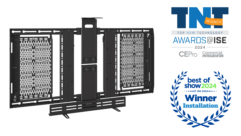

Nice Shot, Mate: AV Down under
Clocked at nearly 150 MPH, Andy Roddick’s serve was the fastest recorded at last January’s Australian Open tennis tournament. But that speed was no match for the integrated network that distributed the radar gun’s data throughout Melbourne Park, the sprawling sports facility that hosts the Grand Slam event.
PREP WORKDID WE MENTION THE HEAT?
Throughout the two-week long Australian Open, IDS staffers working in a central location receive real-time scoring data and distribute it throughout Melbourne Park, as well as to broadcasters and other parties.
Credit: Dennis M. Sabangan/EPA/Corbis
CHALLENGE: Feed the world’s die-hard tennis fans real-time, graphical data from the season’s first Grand Slam tournament via broadcast channels, digital signage, and the Internet.
SOLUTION: Build a dedicated network with custom graphical templates and plug it into a variety of media outlets for seamless AV-IT integration.
CLOCKED AT NEARLY 150 MPH, ANDY Roddick’s serve was the fastest recorded at last January’s Australian Open tennis tournament. But that speed was no match for the integrated network that distributed the radar gun’s data throughout Melbourne Park, the sprawling sports facility that hosts the Grand Slam event. Within seconds of the ball leaving the American pro’s racket, fans everywhere saw what just happened.
The 14,820 on hand at Rod Laver Arena for the match saw the serve speed immediately displayed on a dedicated, IBM-branded LED board positioned right on the court. Almost simultaneously, thousands of others in and around Melbourne Park’s sprawling tennis grounds saw the speed flash on the myriad closed-circuit display devices dispersed throughout the 18-court tennis grounds, as well as in the adjacent hotels.
But the speed reading didn’t stop there—within seconds, it was all over the globe.
The broadcast announcers calling the match for calling some of the 2 billion television viewers worldwide had access to this data, too. So did subscribers to Tennis Australia, the interactive TV channel that allows viewers to browse statistics while they watch a match. And so did the portion of the 6.6 million unique visitors to the Australian Open Web site who were logged on at the time.
At the heart of this data transfer was an end-to-end integrated scoring system installed by the tournament’s longtime technology partner, IBM, and the subcontractors that work with the company.
And serve speeds are only a small part of the story. In a nutshell, this system takes real-time scoring data that’s punched into a laptop computer by statisticians and chair umpires sitting courtside, then distributes that information—packaged in a wide variety of custom-designed analog and digital templates—to a range of interested sources both locally and around the globe. It’s a specialized AV-IT network that requires a range of expertise and technology.
“We bring all the network hubs, servers, laptops, and applications needed to set up the network,” explains Gary Pinkien, director of event technology for Information & Display Systems (IDS), the Jacksonville, Fla.–based systems integrator that’s worked for IBM on the Australian Open almost every year since the technology giant first partnered with the tourney in 1993.
For IDS—a 24-year-old company that specializes in setting up of computer-based scoring systems for sporting events, including those put on by the NBA, NHL, and PGA—conducting such an endeavor involves not only skilled network integration, but intricate logistical planning and a bit of sports-broadcasting savvy.
Preparation for the Australian Open starts months in advance, with IDS programmers tweaking proprietary software applications to meet the needs of the tournament and its various broadcast partners. For example, the various TV production crews covering the Open that plan to embed IDS scores and stats into their graphics will require that this data be packaged with a specific look.
“We write our own scoring system, and we create our own graphics based on what the tournament look is,” explains Pinkien, who coordinates the interaction among all IDS departments. “We have to make sure it all works and that the computers are imaged properly before we ship out.”
Once all the various software tools are modified to fit the needs of the tournament, several hundred notebook computers (for the last Open, IDS deployed 300 IBM notebook computers, mostly newer-model ThinkPad T43s) are loaded into an ocean liner along with, as Pinkien lists them offhandedly, “power-strip extension cords, printers, LED displays, monitors, Cisco hubs and switches, graphics machines, and a ton of other stuff.”
For an Aussie Open, Pinkien’s team will pack about 40 network switches—Cisco models 2950, 2940, 3620, 3550, 3560, and 3524, plus about 10 TV One CS-450 scan converters to help serve TV broadcasters and close-circuit operations. Two IBM BladeCenter servers (model 8678-51X) are also shipped to provide the network’s backbone, with one serving as a backup. IDS also packs up a number of 40-inch Barco displays for the on-site team that monitors network operations.
For this most recent Australian Open assignment, IDS shipped everything out in early October, about three months before the first tennis ball was served. “This way, we could have everything down there and cleared by customs right after Christmas,” Pinkien explains.
IDS manages sprawling sports events such as the Australian Open from a centralized nerve center, which coordinates the network backbone for its proprietary scoring system.Photo:
Credit: Courtesy Information & Display Systems
Once all of the gear arrives and gets cleared, a team of about 50 IDS engineers—all clad in IBM shirts—descends on Melbourne Park and begins to set up the network.
Essentially, the task involves establishing data entry points at each of the Open’s 18 courts, then linking them all to a centralized broadcast station built around the IBM servers. The job is made easier by the fact that the facility is permanently Ethernet-wired to support such network infrastructure.
Melbourne Park also has an existing and up-to-date closed-circuit display system that IDS engineers can simply plug into. “It’s in play already; the infrastructure is already there,” Pinkien explains. “We just have to provide the signal off the laptop.”
For each chair umpire, IDS engineers set up a ThinkPad-equipped data entry station that connects directly to the scoreboard. The two biggest “show courts,” the Rod Laver and Vodofone Arenas, have identical 16mm-pitch LED boards measuring 12.5 x 20 feet, with resolutions of 240×384 pixels.
In addition to radar hookups to track serve speeds, the six show courts, which are the premier venues set up for the biggest matches, also include at courtside a ThinkPad-equipped statistician’s table in which granular data about each match is entered into the scoring system.
All of this data—scoring from the chair umpire, the detailed stats, and the radar speeds—is routed via Ethernet to the server, where it is combined with other sources, such as info from the World Tennis Association database.
From this centralized broadcast station that IDS builds itself, the firm’s control-room staffers interact with a variety of clients. For example, working adjacent to them are their colleagues on the IBM Internet Services team, who will take the real-time match data directly off the BladeServers and webcast it on the official Australian Open site.
Meanwhile, back at courtside, several other IDS staffers are collaborating closely with this nerve center as they serve the tournament’s broadcast partners and close-circuit display operations people.
As Serbian Novak Djokovic defeated Frenchman Jo-Wilfred Tsonga to claim the men’s singles championship on Jan. 27, for example, an IDS scoring specialist worked alongside several TV broadcast crews, taking their live video feeds on his laptop and combining them with stat-laden graphics packages being piped in from the server, then outputting it all back to these broadcasters in standard NTSC and PAL via a TV One Eclipse CS-450 scan converter.
Simultaneously, these IDS specialist were able to take this broadcast feed and scoring data and provide it in analog format to the tournament’s close-circuit display operations staff. Close-circuit operators could, in turn, temporarily cut away from the real-time scoring data being displayed on the main courtside scoreboard and replace it with a clip of Djokovic’s most recent serve. Embedded into that video would be IDS’ graphics package noting, for example, how many aces the player had during the match.
Of course, setting up a network outdoors in the middle of the Australian summer presents challenges—temperatures regularly exceed 100 degrees in Melbourne, and thunderstorms are often an issue. “Luckily, they’ve got pretty good facilities over there,” Pinkien notes. “There’s usually plenty of cover for our laptops.”
Still, preparation is important. With ThinkPads so vital to the operation, Pinkien makes sure he packs plenty of spares. And there’s a reason why two BladeCenter servers are lugged Down Under. “We try to have two of everything—a primary and a backup—and we have everything on UPS systems,” he adds. “That way, if we take an electrical hit, the system stays up.”
EQUIPMENT LIST
Information & Display Systems shipped the following gear to Australia well in advance of this year’s Australian Open tennis tournament. The facility already had in place many AV systems required for closed-circuit display, broadcasting, and other requirements.
Various 40-inch Barco displays (for network monitoring)
Various Cisco Catalyst 2950, 2940, 3620, 3550, 3560, 3524 switches
2 IBM BladeCenter 8678-51X servers
300 IBM ThinkPad T43s notebook computers
10 TV One Eclipse CS-450 scan converters
— SOURCE: INFORMATION & DISPLAY SYSTEMS
Of greater challenge, Pinkien says, is the task IDS staffers must perform after their network is established. In the production area, for example, engineers must conduct broadcast-center operations, communicating each morning with the tournament’s close-circuit production staff to figure out the day’s programming.
“If this isn’t organized properly, you’ll have the tournament people running in every five minutes yelling, ‘show this or show that,’” Pinkien says. “It helps if we figure out in advance what we’re going to show that day—write a script, so to speak.”
Supporting broadcast and close-circuit partners also calls for intimate knowledge of the game. For the IDS officials working alongside these clients, merely blending video images with stats is not enough—they must also know what stats are relevant.
“You could have Andy Roddick playing Roger Federer, and Roddick hits his 30th ace. That’s big news,” Pinkien explains. “You have to know tennis to work with world-feed broadcast.” Indeed, the statistician must be able to highlight such notable number so that broadcast team can properly tell the story.
“We’re there for our expertise as far as servers and routers, but we always have to have someone who knows the game and how to score it and stat it,” Pinkien adds.
Daniel Frankel is a freelance writer in Los Angeles. He can be reached at [email protected].










